Madlener House
4 West Burton Place
Chicago, Illinois 60610
Telephone: 312.787.4071
info@grahamfoundation.org
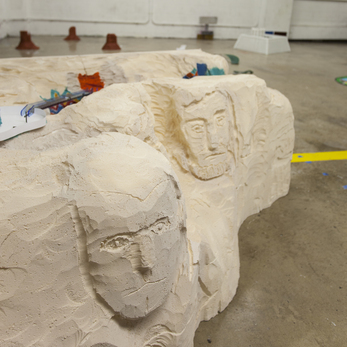
On Tuesday, April 7, Italian architect, writer, and editor Pier Paolo Tamburelli will present the research that he recently conducted as the Douglas A. Garofalo Fellow at the School of Architecture, University of Illinois Chicago. Tamburelli’s project looks back to Austrian architect Johann Bernhard Fischer von Erlach’s influential book Entwurff einer historischen Architektur (1721) in an attempt to imagine a realistic, collective, and comparative approach to contemporary architecture.
Pier Paolo Tamburelli is an Italian architect, writer, and editor of Milan-based San Rocco magazine. In 2004, together with Paolo Carpi, Silvia Lupi, Vittorio Pizzigoni, Giacomo Summa, and Andrea Zanderigo, he founded baukuh, an architectural collective based in Milan and Genoa. baukuh has won numerous international competitions; produced master plans; built public and mixed-use buildings; restored public buildings; and curated exhibitions. baukuh took part in the Rotterdam Biennale (2007 and 2011); the Istanbul Biennial (2012); the Venice Biennale (2008 and 2012); and was part of the research group for the Dutch National History Museum (2011). Tamburelli has lectured at a number of schools and cultural institutions, including the Architectural Association; Cornell University; EPFL Lausanne; FAU São Paulo, among many others. He studied at the University of Genoa and at the Berlage Institute Rotterdam, and has taught at the PUSA Aleppo (Syria); the Berlage Institute Rotterdam; TUM Munich; and FAUP Porto. He is currently unit professor at the Milan Politecnico.
Image: Pier Paolo Tamburelli, Mount Rushmore; and Monument Valley (background), 2014.
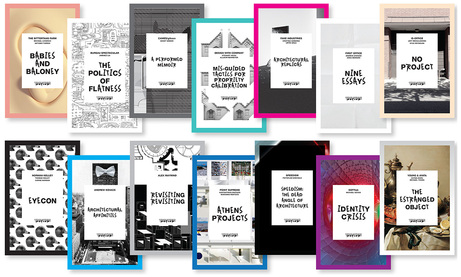
Please join us for a panel discussion and book launch to conclude our current exhibition and publication project Treatise: Why Write Alone?
On March 28th, Jimenez Lai will be joined by representatives from all fourteen offices to debate the collective and individual stakes that have emerged from this temporary allegiance of designers. All together for the first time, the participants will discuss their own work as well as the perceived outcomes of this project for the participants and within the architectural field. RSVP is required for the morning and afternoon panel sessions.
Please note: Seating will be very limited, and event entry will be on a first-come, first-serve basis. RSVP does not guarantee entry, so please plan to arrive early.
PROGRAM OF EVENTS
9:00AM-12:30PM: Morning Session (RSVP required)
Swerves of the Curves: The Projective Misuse of Softness
CAMESgibson, Design with Company
Rainbows, Bricks and Balloons: The Translucent, Sexual and the Deliciousness
SOFTlab, Bittertang
On Nothingness: The Terrors of White Noise
First Office, Norman Kelley, Is Office
12:30PM-2:00PM: Break for Lunch
2:00PM-5:30PM: Afternoon Session (RSVP required)
Why Philosophy Alone? Of Objects, Measures, Cultures and the Cosmos
Young Ayata, Alex Maymind, Fake Industries
Mess is More: an Ode to the Scatter-Minded Court Jesters
Andrew Kovacs, Speedism, Point Supreme
Open Discussion
6:00PM-8:00PM: Book Launch Party (RSVP optional)
PUBLICATION
Both the complete set and individual volumes (116-pages each; $20) will be available for purchase at the Graham Foundation bookshop. All pre-orders made before the launch will receive a 10% discount. Please contact bookshop@grahamfoundation.org for more information on purchasing.
Bittertang, Babies and Baloney
Bureau Spectacular, The Politics of Flatness
CAMESgibson, A Performed Memoir
Design With Company, Mis-guided Tactics for Propriety Calibration
Fake Industries Architectural Agonism, Four Hypotheses on the Use of Agonistic Copies in the Architectural Field
First Office, Nine Essays
Pieterjan Ginckels, SPEEDISM: The Dead Angle of Architecture
is-office, No Project
Andrew Kovacs, Architectural Affinities
Alex Maymind, Revisiting Revisiting
Norman Kelley, Eyecon
Point Supreme, Athens Projects
SOFTlab, Identity Crisis
Michael Young, The Estranged Object
For more information on the exhibition, Treatise: Why Write Alone?, click here.
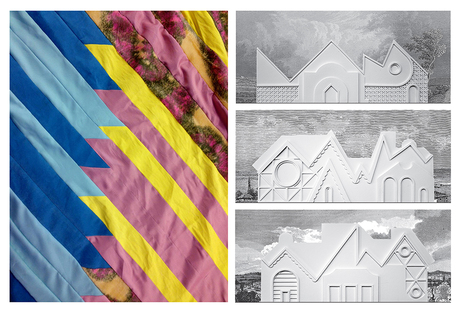
Please join us for presentations by Chicago-based designers Grant Gibson of CAMESgibson and Allison Newmeyer and Stewart Hicks, co-founders of the architecture collaborative Design With Company (Dw/Co), whose works are featured in Treatise: Why Write Alone?—the Graham Foundation’s current exhibition and publication project that brings together fourteen young conceptual design offices to explore the architectural treatise as a platform for debate. Recalling his collaboration with T. E. Cames, the influential, yet fictional partner of CAMESgibson, Gibson will discuss the emergence of the memoir as a viable design construct for the contemporary performance-oriented culture, while Newmeyer and Hicks will discuss architecture and learning from the everyday, collage fiction, corn and character.
Grant Gibson is a Chicago-based educator, registered architect, and founding principal of CAMESgibson, Inc.,an architecture and design practice committed to creating environments and objects that are cross-pollinated with common social, political, and economic interests, as well as individual experiences and desires. Gibson received his MArch from the University of Illinois at Chicago, and holds degrees from Purdue University in architectural engineering and construction engineering technology. He is currently clinical assistant professor at the University of Illinois at Chicago.
Design With Company (Dw/Co) is the Chicago-based architectural collaborative of Stewart Hicks and Allison Newmeyer. Dw/Co seeks to transform the world through textual and visual narratives, speculative urban scenarios, installations, and small-scale interactive constructions. Stewart Hicks received his MArch from Princeton University and is currently assistant professor of architecture at the University of Illinois at Chicago. He is a fellow of the MacDowell Artist Colony and a recipient ofArchitectural Record's Design Vanguard Award and the Young Architect's Forum Prize. Alison Newmeyer is visiting assistant professor at the University of Illinois at Chicago and also teaches at the University of Wisconsin–Milwaukee and the Illinois Institute of Technology. She is a fellow of the MacDowell Artist Colony and is the recipient of architectural awards from the Van Alen Institute and Architizer.
Images (left to right): CAMESgibson, Victory Column of T. E. Cames (detail), 2015. Fabric and foamcore. 204 x 14 x 14 inches. Design with Company, Midwest Culture Sampler (Department of Quantity, Scale, Image), 2015. Three archival inkjet prints. 26 x 11 1/4 inches each.
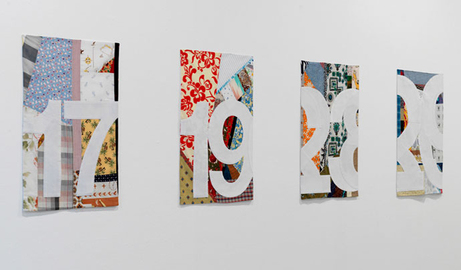
Karen Reimer, "Endless Set #17-29," 2007. Sewn fabric. 30 x 20 inches. Courtesy the artist and Monique Meloche.
The Graham Foundation Bookshop is pleased to host the launch of Endless,—the first major publication on the work of pioneer craft artist Karen Reimer. Published by Gallery 400 and WhiteWalls, the catalogue not only surveys this innovative artist’s work, but also rethinks the canonical relationship between architecture and craft.
Endless, includes important essays by leading cultural critic Lauren Berlant, architectural critic Penelope Dean, and art historian Judith Russi Kirshner, as well as an interview with the artist by Gallery 400 director Lorelei Stewart. These essays boldly theorize a new relationship of craft to labor and explore how this groundbreaking artist entwines craft, art, and contemporary issues.
Reimer will be signing copies of her new publication, which will be available for purchase in our bookshop. The event will also feature a Q&A with the artist moderated by Lorelei Stewart. Endless is supported by a Craft Research Fund grant from the Center for Craft, Creativity and Design, Inc. and by the Andy Warhol Foundation for the Visual Arts.
Karen Reimer produces work that expansively addresses the larger relationship of craft to modernist and postmodernist cultural aims. For Reimer, craft is a means to explore architectural concerns, minimalist issues, questions of labor, and connotations within the domestic or vernacular. She has had solo exhibitions at Monique Meloche Gallery, Chicago; the Rochester Art Center, MN; the Riverside Arts Center, IL; Schopf Gallery, Chicago; and the Hyde Park Art Center, Chicago. Her work has been included in group shows at the Museum of Contemporary Art, Chicago; the Contemporary Craft Museum, Portland, Oregon; and Wallspace Gallery, New York, among others. Reimer is the recipient of an Artadia Individual Artist grant and a Richard A. Driehaus Individual Artist award. Her work has been included in the publications By Hand: The Use of Craft in Contemporary Art (Princeton Architectural Press, 2010); The Object of Labor: Art, Cloth, and Cultural Production (MIT Press, 2007); and Contemporary Textiles (Black Dog Press). She is currently an instructor in Fiber and Material Studies at the School of the Art Institute of Chicago. Reimer completed a BA at Bethel College, North Newton, KS, and an MFA at the University of Chicago.
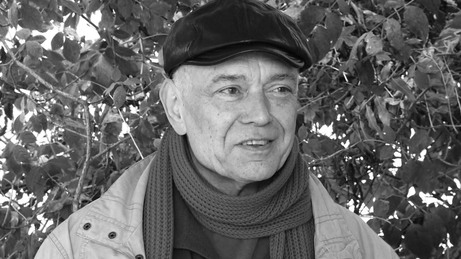
As part of a Chicago-wide festival celebrating German composer Mathias Spahlinger’s 70th year, the Graham Foundation will host a performance of three of the composer’s works. Suono Mobile will present his early fünf stücke für zwei klavier (1969) and the explosive octet aussageverweigerung/gegendarstellung (1981), and the Illinois Modern Ensemble and conductor Stephen Andrew Taylor will perform Spahlinger's large ensemble work furioso (1991), along with in nuce (2003/2009) by former Spahlinger protégé Philipp Blume.
This performance is the fourth concert in the Spahlinger festival, a 10-day residency and retrospective of his music and thought. The first of its kind in the States, this festival presents six concerts and a symposium, all free and open to the public, and brings together renowned musicians and scholars from Chicago, New York, Berlin, Zürich, and Basel.
The Illinois Modern Ensemble comprises students dedicated to the performance of contemporary and experimental music. Its repertoire in recent seasons includes works by leading figures such as Steve Reich, George Friedrich Hass, and Augusta Read Thomas, as well as a constant stream of new works by student and faculty composers.
Suono Mobile USA was established in 2012 by saxophonist Nathan Mandel and composer Philipp Blume. As part of the larger Suono Mobile initiative for new music worldwide, Suono Mobile USA is a modular collective, a sort of “think tank,” for presenting and curating modern and new musical works, programs, and art/music initiatives.
there is no repetition. Mathias Spahlinger at 70
http://norepetition.tumblr.com/
there is no repetition: complete program
http://norepetition.tumblr.com/completeprogrampdf
Unless otherwise noted,
all events take place at:
Madlener House4 West Burton Place, Chicago
GALLERY AND BOOKSHOP HOURS
2025 Chicago Architecture Biennial
SHIFT: Architecture in Times of Radical Change
Sep 19, 2025–Feb 28, 2026
Wed–Sat, 12–5 p.m.
To make an appointment, email: bookshop@grahamfoundation.org
CONTACT
312.787.4071
info@grahamfoundation.org
Accessibility
Events are held in the ballroom on the third floor which is only accessible by stairs.The first floor of the Madlener House is accessible via an outdoor lift. Please call 312.787.4071 to make arrangements.
Copyright © 2008–2025 Graham Foundation. All rights reserved.
 PREVIOUS POSTS
PREVIOUS POSTS